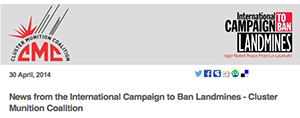27 August 2015
More harm from cluster munitions in Yemen

Fatima Ibrahim al-Marzuqi is being carried by her brother because she is not able to walk due to her injuries sustained during a cluster munition attack on Malus village on June 7. © 2015 Ole Solvang/Human Rights Watch
Dozen of civilians have been killed or injured in Yemen as a result of cluster munition attacks that appear to have been conducted by the coalition forces led by Saudi Arabia, reported Human Rights Watch on 27 August 2015. The attacks were carried out between late April and mid-July 2015.
Cluster munitions caused civilian casualties both during the attacks, which may have been targeting Houthi fighters, and afterward, when civilians picked up unexploded submunitions that detonated.
The Cluster Munition Coalition calls on Saudi Arabia and other states involved to immediately stop using cluster munitions and to join the 2008 Convention on Cluster Munitions. All states should condemn the use of cluster munitions in Yemen. Any use of cluster munitions by any actor under any circumstances is unacceptable.
Several of the attacks took place in or near areas with concentrations of civilians. In July, Human Rights Watch visited four of the seven attack sites, all in the Haradh and Hayran districts of Hajja governorate. Unexploded submunitions or remnants of cluster munition rockets were found at each site.
Unexploded submunitions were scattered in fields normally used for agriculture and grazing. Because of the unexploded submunitions, these areas have become too hazardous to use, threatening the livelihoods of local farmers and adding to food insecurity.
Human Rights Watch identified the weapons used in all seven attacks as United States-made, ground-launched M26 cluster munition rockets. The M26 is delivered by the M270 Multiple Launch Rocket System (MLRS), which carries 12 rockets, or the M142 High Mobility Artillery Rocket System (HIMARS), which carries 6 rockets, to a range of 10 to 32 kilometers.
Each M26 rocket contains 644 M77 Dual Purpose Improved Conventional Munitions (DPICM) submunitions that are dispersed over a 200-by-100 meter area. A volley of six rockets releases 3,864 submunitions over an area with a one-kilometer radius.
The M77 submunitions have a significant failure rate, up to 23 percent in US military testing, which means that unexploded bomblets remain in the area, posing a serious hazard until they are located and safely cleared.
Although the evidence is not definitive, a range of factors indicate that the Saudi-led coalition carried out the seven attacks. Neither Yemen, Saudi Arabia, nor any members of the coalition are States Parties to the Convention on Cluster Munitions.


